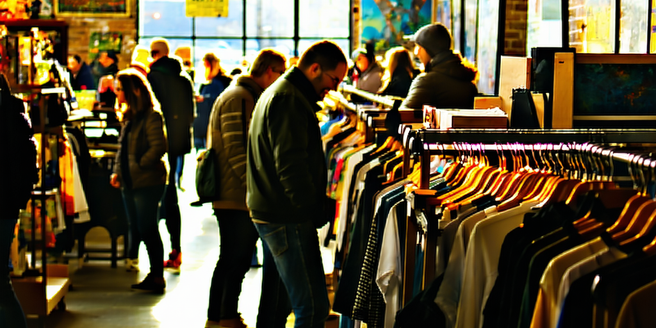
Understanding Mindful Thrifting: A New Approach
Mindful thrifting is more than just a trend; it’s a thoughtful way to engage with consumerism by prioritizing need and intention over impulse buying. By focusing on what truly enhances your life, mindful thrifting encourages a deeper understanding of your consumption habits. It starts with recognizing the value of pre-loved items and shifts away from the allure of fast fashion and its unsustainable cycles. By only purchasing items that serve a purpose, it reduces waste and promotes a more responsible way of living. Mindful thrifting embraces the imperfections, allowing individuals to connect with items on a personal level, exploring the stories they carry. This approach leads to sustainable consumer habits that honor both the environment and personal values, fostering a sense of fulfillment and resourcefulness that unchecked consumerism seldom achieves.
Benefits of Mindful Thrifting for Personal Growth
Engaging in mindful thrifting can vastly contribute to personal growth by teaching patience, creativity, and resourcefulness. It encourages individuals to take time in making purchasing decisions, thus enhancing the ability to live in the moment and appreciate the journey of finding unique treasures. This method not only supports sustainability by reducing demand for new products but also fosters a creative spirit as one learns to style and intermingle diverse pieces in innovative ways. The emotional satisfaction derived from mindful thrifting helps in building a more self-aware consumer identity that values quality and character over quantity. Additionally, it promotes a connection to the community by supporting local thrifts, which often channel resources back into neighborhood projects, providing a deeper sense of belonging and purpose beyond oneself.
Practical Tips for a Successful Thrifting Experience
For a fruitful thrifting journey, preparation is key. Start by setting clear intentions about what you need and avoid unnecessary splurges. It’s also wise to frequently visit thrift stores, as their stock changes regularly. Patience is your best ally; the best finds may require time and persistence. Examine items thoroughly for quality, as thrifted goods can vary greatly in condition. Consider supporting local thrift shops, which often contribute more directly to community initiatives. Enhance your thrifting acumen by learning how to assess fabrics and brands, recognizing those known for durability and timeless style. Remember, thrifting is not just a transaction but an experience that invites creativity and fosters a personal connection with your purchases. Embrace the adventure, and be open to discovering unexpected gems that resonate with your personal style and values.
Creative Repurposing: Breathing New Life into Finds
Repurposing is at the heart of mindful thrifting, turning outdated or seemingly mundane items into something fresh and unique. It involves seeing the potential in an object beyond its current use, fostering both creativity and sustainability. For instance, an oversized shirt can be redesigned into a trendy dress or a set of chic throw pillows. This process not only saves money but also keeps items out of landfills, contributing positively to environmental conservation efforts. Moreover, creative repurposing allows for a personalized touch in your belongings, reflecting individual style and innovation. It’s a fulfilling practice that encourages a connection with each item, valuing its history and possibilities for reinvention. By sharing repurposing ideas and projects, communities can inspire each other to see the beauty and potential in the forgotten or discarded.
Building a Sustainable Wardrobe on a Budget
Constructing a sustainable wardrobe doesn’t require extravagant spending if approached thoughtfully. Start by evaluating what you own to identify gaps and unnecessary excess. Thrift stores offer an economical avenue to fill wardrobe gaps with quality items, often at a fraction of retail prices. Prioritize versatile, timeless pieces that form the base of your wardrobe, allowing multiple styling options. While cost-effective, focus on durability to ensure the longevity of your clothes, thereby reducing waste. Investing time in learning basic repair skills like sewing can extend the life of garments, adding to their value and reducing your fashion footprint. By maintaining a mindful approach to clothing acquisition, you cultivate a wardrobe that not only meets your budget but also aligns with sustainable and ethical fashion principles, promoting environmental stewardship and personal satisfaction.
